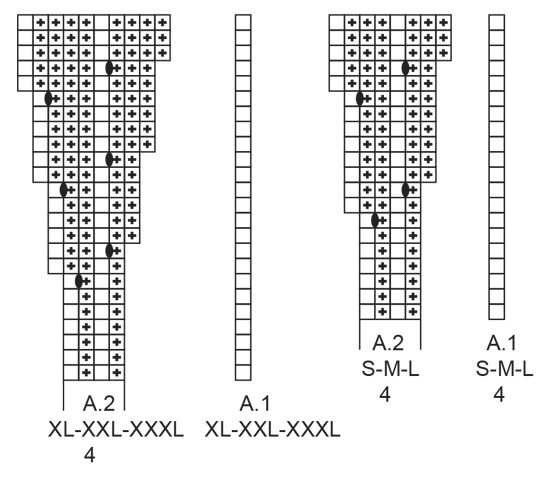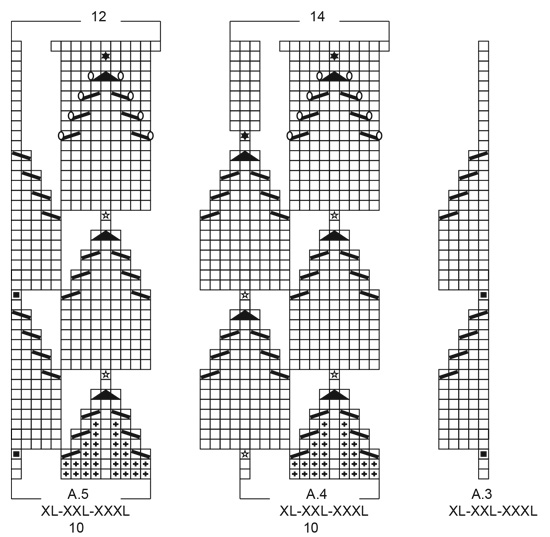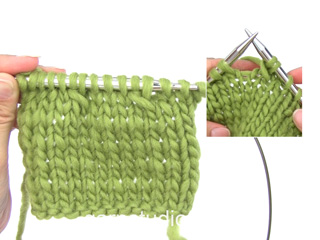Alberta Rose Jacket |
|||||||||||||||||||||||||||||||
 |
 |
||||||||||||||||||||||||||||||
Knitted jacket with round yoke in DROPS Safran. The piece is worked top down with lace pattern, leaf pattern and ¾-length sleeves. Sizes S - XXXL.
DROPS 212-6 |
|||||||||||||||||||||||||||||||
|
------------------------------------------------------- EXPLANATIONS FOR THE PATTERN: ------------------------------------------------------- PATTERN: See diagrams A.1 to A.5. Choose diagrams for your size. The diagrams show all the rows in the pattern seen from the right side. INCREASE TIP-1 (for sides of body): All increases are worked from the right side! Work until there are 2 stitches left before the marker thread, make 1 yarn over, knit 4 (marker thread sits between these 4 stitches), make 1 yarn over. On the next row work the yarn overs twisted to avoid holes. Then work the new stitches in stocking stitch. INCREASE TIP-2 (evenly spaced): To work out how to increase evenly, count the total number of stitches on the needle (e.g. 257 stitches) minus the bands (e.g. 14 stitches) and divide the remaining stitches by the number of increases to be made (e.g. 64) = 3.79. In this example, increase by making 1 yarn over after approx. each 4th stitch. On the next row work the yarn overs twisted to avoid holes. DECREASE TIP (for sleeves): Decrease 1 stitch on each side of the marker thread as follows: Work until there are 3 stitches left before the marker thread, knit 2 together, knit 2 (marker thread sits between these 2 stitches), slip 1 stitch as if to knit, knit 1 and pass the slipped stitch over the knitted stitch. CASTING-OFF TIP: To avoid the cast-off edge being tight you can cast off with a larger size needle. If the edge is still tight, make 1 yarn over after approx. each 4th stitch at the same time as casting off and the yarn overs are cast off as normal stitches. . BUTTONHOLES: Work buttonholes on right band (when garment is worn). Work from the right side when there are 4 stitches left on row as follows: Make 1 yarn over, knit 2 together and knit the last 2 stitches. On the next row (wrong side) knit the yarn over to leave a hole. The first buttonhole is worked when the neck measures 1½-2 cm. Then work the other 6-6-7-7-7-7 buttonholes with approx. 7-7-7½-7-7-7½ cm between each one. ------------------------------------------------------- START THE PIECE HERE: ------------------------------------------------------- JACKET – SHORT OVERVIEW OF THE PIECE: The neck and yoke are worked back and forth with circular needle, from mid front and top down. The yoke is divided for body and sleeves and the body is continued back and forth with circular needle. The sleeves are worked in the round with double pointed needles, top down. NECK: Cast on 123-131-139-139-143-155 stitches (including 7 band stitches on each side towards mid front) with circular needle size 2.5 mm and Safran. Purl 1 row (= wrong side). The next row is worked as follows from the right side: Knit 2, purl 2, knit 1, purl 2 (= band), A.1 (= 1 stitch), A.2 (= 4 stitches) until there are 7 stitches left on the row (= 27-29-31-31-32-35 times in width) and over the band purl 2, knit 1, purl 2, knit 2. Remember the BUTTONHOLES – see description above. When the first 6 rows of the pattern have been worked, change to circular needle size 3.5 mm. Insert 1 marker after the band at the beginning of the row; the yoke will be measured from this marker! YOKE: Continue the pattern as before and increase as shown in A.2. When A.1 and A.2 have been worked 1 time in height there are 231-247-263-325-335-365 stitches on the row. The piece measures approx. 5-5-5-6-6-6 cm from the marker. On the next row from the right side work as follows: Knit 2, purl 2, knit 1, purl 2 over the band stitches as before, A.3 (= 1 stitch), A.4 (= 8-8-8-10-10-10 stitches) until there are 15-15-15-17-17-17 stitches left (= 26-28-30-30-31-34 times in width), A.5 (= 8-8-8-10-10-10 stitches) and over the band purl 2, knit 1, purl 2 and knit 2. REMEMBER THE KNITTING TENSION! When A.3 to A.5 have been worked 1 time in height there are 337-361-385-447-461-503 stitches on the row. The piece measures approx. 16-16-16-21-21-21 cm from the marker. Continue with stocking stitch and knit over knit and purl over purl on the bands until the piece measures 18-20-21-23-25-27 cm from the marker. Now divide the piece for body and sleeves as follows: Work the first 53-56-59-69-71-80 stitches, place the next 70-74-80-93-94-98 stitches on a thread for the sleeve and cast on 8-8-10-8-12-10 stitches under the sleeve, work 91-101-107-123-131-147 stitches, place the next 70-74-80-93-94-98 stitches on a thread for the sleeve and cast on 8-8-10-8-12-10 stitches under the sleeve and work the last 53-56-59-69-71-80 stitches. BODY: = 213-229-245-277-297-327 stitches. Insert 1 marker thread 57-60-64-73-77-85 stitches in from each side (= sides of body). There are 99-109-117-131-143-157 stitches between the marker threads on the back piece. Allow the threads to follow your work onwards; they will be used when increasing in the sides. Continue with stocking stitch and knit over knit and purl over purl on the bands as before. When the piece measures 3 cm from the division increase 1 stitch on each side of both marker threads – read INCREASE TIP-1 (= 4 stitches increased). Increase like this every 2½ cm a total of 7 times = 241-257-273-305-325-355 stitches. Continue working until the piece measures 26-26-27-27-27-27 cm from the division. (or to desired length; there are 4 cm left to finished length). Knit 1 row from the right side and increase 62-64-66-67-68-68 stitches evenly spaced (band stitches worked as before) – read INCREASE TIP-2 = 303-321-339-372-393-423 stitches. The increase is done to prevent the rib being tight. Change to circular needle size 2.5 mm and work the next row from the wrong side as follows: Purl 2, knit 2, purl 1, knit 2 on the band as before, * purl 1, knit 2 *, work from *-* until you have 8 stitches left on the row, purl 1 and then, on the bands, knit 2, purl 1, knit 2, purl 2 as before. Continue this rib for 4 cm. Cast off with knit from the right side – read CASTING-OFF TIP. SLEEVES: Place the 70-74-80-93-94-98 stitches from the thread on the one side of the piece onto double pointed needles size 3.5 mm and knit up 1 stitch in each of the 8-8-10-8-12-10 stitches cast on under the sleeve = 78-82-90-101-106-108 stitches. Insert 1 marker thread in the middle of these 8-8-10-8-12-10 new stitches under the sleeve. Allow the thread to follow your work onwards; it will be used when decreasing mid under sleeve. Work in the round in stocking stitch. When the piece measures 2 cm from the division decrease 1 stitch on each side of the marker thread – read DECREASE TIP (= 2 stitches decreased). Decrease like this every 2½-2-1½-1-1-1 cm a total of 9-10-13-17-18-18 times = 60-62-64-67-70-72 stitches. When the sleeve measures 30-28-28-26-25-23 cm from where the sleeve was divided from the body, increase 6-7-8-5-8-6 stitches evenly spaced = 66-69-72-72-78-78 stitches. Change to double pointed needles size 2.5 mm and work rib (= knit 1 / purl 2) over all stitches. Cast off with knit when the sleeve measures 34-32-32-30-29-27 cm from the division. Work the other sleeve in the same way. ASSEMBLY: Sew the buttons onto the left band. |
|||||||||||||||||||||||||||||||
Diagram explanations |
|||||||||||||||||||||||||||||||
|
|||||||||||||||||||||||||||||||

|
|||||||||||||||||||||||||||||||

|
|||||||||||||||||||||||||||||||

|
|||||||||||||||||||||||||||||||

|
|||||||||||||||||||||||||||||||
|
Have you made this or any other of our designs? Tag your pictures in social media with #dropsdesign so we can see them! Do you need help with this pattern?You'll find tutorial videos, a Comments/Questions area and more by visiting the pattern on garnstudio.com. © 1982-2024 DROPS Design A/S. We reserve all rights. This document, including all its sub-sections, has copyrights. Read more about what you can do with our patterns at the bottom of each pattern on our site. |
|||||||||||||||||||||||||||||||






































































Comments / Questions (34)
Hola. Un comentario y una pregunta Comentario: en la talla s hay que poner 124 puntos, no 123, para que se puedan hacer las repeticiones Pregunta: si uso una lana que tejo con agujas de 5.5 mm, y cojo la talla s, quedará muy grande? La lana no es drops, es una que ya tenía y no pone el grosor, así que cómo puedo saber a qué categoría de grosor corresponde una lana que no es drops? Gracias
21.08.2021 - 15:20DROPS Design answered:
Hola Carina, para saber a qué categoría pertenece puedes hacer una muestra de la tensión del tejido con la aguja elegida y calculas cuántos puntos y filas hay en 10 cm. Si te parece que el tejido queda demasiado flojo o tenso, se puede variar el número de la aguja. En cuánto a la talla S, sí, debido a la diferencia en grosor entre el hilo de la labor y el hilo que has descrito, la talla S quedará bastante más grande. Por otro lado, 123 puntos son correctos. Son 7 puntos de la cenefa a cada lado (7+7) + A.1 (=1 punto)+ A.2 (4x27 = 108 puntos). 14 +108+1= 123
23.08.2021 - 13:10Megkötöttem az A1-A2 összes sorát és 263 szemem van a tűn. A leírás szerint 325 szemnek kellene lennie. Az L-es méretet készítem, kezdő szemszam: 139. Ha ezek a megfelelő mérethez tartozó kezdő szemszamok: xs-123, s-131, m-139, l-139, xl-143,xxl-155. A minta leírásában csak xxl-es méret van megadva, míg az ábrán (A3-A4) XXXL is van.Hogyan folytassam tovább A3-A4 8-as szemszam vagy 10-es szemszam? Félek nem lesz jó a méret.Előre is köszönöm a segítséget!
16.08.2021 - 14:57Megkötöttem az A1-A2 összes sorát és 263 szemem van a tűn. A leírás szerint 325 szemnek kellene lennie. Az L-es méretet készítem, kezdő szemszam: 139. Ha ezek a megfelelő mérethez tartozó kezdő szemszamok: xs-123, s-131, m-139, l-139, xl-143,xxl-155. A minta leírásában csak xxl-es méret van megadva, míg az ábrán (A3-A4) XXXL is van.Hogyan folytassam tovább A3-A4 8-as szemszam vagy 10-es szemszam? Félek nem lesz jó a méret.Előre is köszönöm a segítséget!
16.08.2021 - 14:44Jag har frågat ang storlekstabell förAlberta Rosé Jacket och fått svar att det finns längst ner på mönstret. Kan inte finna någon måttabell. Behöver veta bystmått o längd innan jag påbörjar arbetet.
10.08.2021 - 13:35DROPS Design answered:
Hej Ingela. Om du ser på mönstret här över, mellan symbolförklaringarna och diagrammen, så hittar du en måttskiss där med mått i cm för alla storlekar. Mvh DROPS Design
17.08.2021 - 14:00Mönster Alberta Rosé Jacket. Har inte köpt garn än . På mönstret finns ingen storleksguide endast s-xxxl, vet inte vilken storlek jag behöver sticka .
03.08.2021 - 17:54DROPS Design answered:
Hej Ingela, jo, du har en måttskiss längst ner i mönstret. Välj storleken på de mått som passar dig :)
04.08.2021 - 08:30I'm knitting the large size. I cast on 139 and worked 1 full pattern of A1 and A2. At the end of the yoke I only have 239 stitches, not 263. I have 14 band stitches (left plus right) and 25 repeats of A1 plus A2. What am I doing wrong? Casting on 139 gives 14 band stitches plus 25 times 5 chart stitches. I don't understand what the pattern means when it states "(=27-29-31-31-32-35 times in width)". 31times 9, plus 14 would make 293 stitches. Love the Pattern! Help please.
02.08.2021 - 15:57DROPS Design answered:
Dar Wendy, if you are knitting the size L, you cast on 139 stitches for the neck edge. After the first row, knitted withpurls, you do the band (=7 stitch), A.1 (= 1 stitch), A.2 (= 4 stitch, 31 times = 124 stitch) and 7 stitches for the band (= 139 stitches. By the time you've knitted all rows of A.2, in each repeat of A.2 (for sie L) you increased 4 stitches (31x4 = 124). If you add that to the 139 stitches you've started with, you hould get the 263 stitch. Happy Stitching!
03.08.2021 - 04:55I am making the Alberta Rose cardigan in size XXL. After ripping out and redoing rows of the yoke charts, I am now onto the stockinette stitch and have come to the section where I need to separate the sleeves from the fronts and back. The stitch count says I should have a total of 461 stitches. I have only 405. The pattern appears to have worked out properly...what could have happened? I am having such a hard time with this pattern even though I am an advanced knitter.
19.04.2021 - 13:58DROPS Design answered:
Dear Mrs Strohman, in XXL there are 14 sts in each A.4 and 12 sts in A.5 when they are done: 7 front band sts + 1 (A.3) + 14stsx31 repeats A.4 + 12 sts A.5 + 7=7+1+.434+12+7=461 sts. Hope this helps, happy knitting!
19.04.2021 - 15:20Guten Morgen! Ja, vielen lieben Dank, die Antworten haben mir sehr geholfen!! 👍😊 Ein schönes Wochenende Uschi
12.03.2021 - 09:00Nochmals vielen Dank, sie müssen mich für komplett unfähig halten. Tut mir leid! Ich hatte schon das Model 335 gestrickt und hatte keine Probleme. Deshalb weiß ich nicht wo mein Fehler ist. Soll ich A1 auch nur einmal am Anfang stricken und dann nur noch A2 ? Irgendwo hab ich ein Denkfehler ganz liebe Grüße und danke für die Hilfe
11.03.2021 - 16:36DROPS Design answered:
Liebe Frau Geisler, ja genau, A.1 muss nur einmal ganz am Anfang (zwischen den Blende-Maschen und A.2) gestrickt werden, damit das Muster symetrisch wird (A.2 beginnt mit 1 Li M und endet mit 1 re M). Kann Ihnen die vorrige Antwort helfen? Es werden alle Maschen beschrieben, wie sie gestrickt werden sollen. Viel Spaß beim stricken!
12.03.2021 - 08:19Vielen lieben Dank für die schnelle Antwort! Das habe ich jetzt verstanden! Wenn ich noch was fragen kann, wenn ich mit der halsblende fertig bin, dann habe ich wenn ich 123 Maschen angeschlagen habe am Ende keine 231 Maschen sondern nur 212 auf der Nadel. Wenn ich dann zusätzlich 19 zunehme stimmt das Muster nicht mehr
11.03.2021 - 14:50DROPS Design answered:
Liebe Frau Geisler, Sie stricken die 1. Größe, korrekt? dann wiederholen Sie 27 Mal A.2 - in A.2 werden jeweils 4 Maschen zugenommen, nach A.2 haben Sie: 7 Blende-Maschen, A.1, 27 x A.2 (= 8 Maschen x 27 Mal = 216 Maschen), 7 Blende-Maschen = 7+1+216+7= 231 Maschen nach A.1/A.2. Viel Spaß beim stricken!
11.03.2021 - 16:09